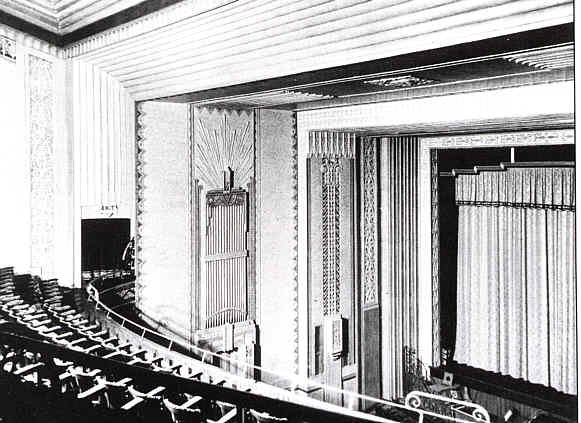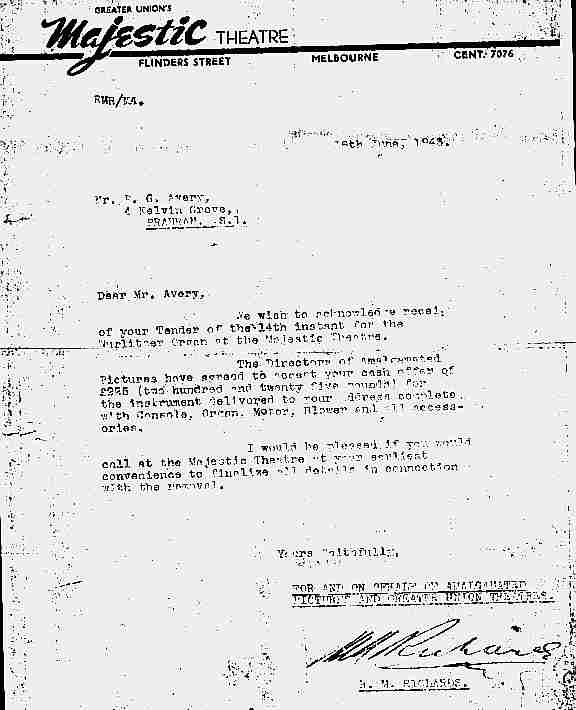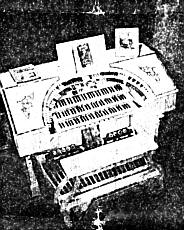
Back to Main Encylopaedia Contents
Majestic Theatre, Melbourne

The Majestic Theatre, on the corner of Flinders and Russell Streets, was built by Amalgamated Pictures Ltd., and opened on 31 August, 1912. [Thorne, Ross, Cinemas of Australia via USA, p. 215] Music for the silent films was provided by "the grand opera orchestra". [TableTalk, 9 September, 1912, p. 16.] In 1916, after Amalgamated Pictures had been incorporated in Union Theatres, the theatre was refurbished and upgraded to the latest standards:
There will be no screen! At least not a visible one. the audience will seem, to be looking out of a huge doorway formed by the proscenium. Where the stage was will be an elevated verandah, vine-covered and flower laden. Across this, glowing in the evening sunset, stretches a vast panorama of river, mountain and forest. A fountain spar-kles in the foreground. At the appointed time the eve-ning fades to darkness, and, out yonder over the sleeping hill and dale, a vision will appear - the play is on.s
Table Talk, 9 September, 1912, p. 16.
No organ was yet provided to enhance this idyllic effect, but this was to come in the autumn of 1919, when a four-rank, Style 135, Wurlitzer arrived. It had been despatched from America, as Opus 202, on 21 January, 1919.
The Style 135 was an updated version of the Style 1 (an example of which had been installed at the Melba Theatre, Melbourne, a couple of years earlier) and was basically built to the same specification.
The organist most associated with this instrument, and who possibly opened it, was Will Westbrook, who was its resident organist for many years. Despite the organ's modest size, his performances on it drew much praise:
Mr Westbrook's organ recitals are much appreci-ated by those who arrive early, and also those not wishing to take advantage of the interval to go outside.
Everyone's, 26 July, 1922
And again, some years later:
Majestic Theatre Building and Show Improvements
Renovations and improvements have been carried out at Union Theatres' Majestic Theatre, which is under the management of Arthur Dawes. Improvements are not only to the building, but to the entertainment itself. During the afternoons the selections by organist Westwood [sic] on the Wurlitzer are a real treat.
The tabs in front of the screen at the conclusion of the slide showing now close smoothly, and the attention and courtesy leave nothing to be desired.
The orchestra at the evening sessions is under the baton of Umberto Curcio.
Everyone's, 20 June, 1928, p. 19.
The only other organists known to have played the Wurlitzer at the Majestic are John Barrett and Albert Wales, both of whom occasionally relieved Arnold Coleman at the State Theatre, Melbourne.
Sound films arrived at the Majestic on 10 May, 1929, after the theatre had been redecorated and fitted with new seats. [Thorne, Ross, Cinemas of Australia via USA, p. 217] Further alterations occurred in 1936, when the gallery was removed and the area above the stalls comprised one cantilevered dress circle. [Thorne, Ross, Cinemas of Australia via USA, p. 217]
At some stage, probably during the 1930s, the piano console was replaced by "a cube design of 3-ply", [Avery, P Geoff, Letter, 18 July, 1978] the specification being modified:
Pedal
Bourdon 16
Flute 8
Cello 8
Bass Drum
Kettle Drum
Cymbal
Accompaniment
Bourdon 16
Flute 8
Salicional 8
Trumpet 8
Vox Humana 8
Flute 4
Salicet 4
Snare Drum
Tambourine
Castanets
Chinese Block
Xylophone re-it
Glockenspiel re-it
Chimes 20 notes
Solo
Bourdon 16
Flute 8
Salicional 8
Trumpet 8
Vox Humana 8
Salicet 4
Flute 4
Effects
Foghorn
Fire Alarm
Telephone Bell
Surf
This was the organ as it was found by Mr Geoff Avery when he purchased it from the theatre on 16 June, 1943 for £225.00, delivered to his Prahran residence. [Bill of sale to Mr Avery, 16 June, 1943]

Mr Avery installed the organ in his residence:
Over a period of years I built a new console, 3-manual, with direct electric piston action (not all of this was com-pleted). Added on
a separate chest was a 2ft Piccolo extension of the
Flute, using some of the spare accompaniment relay
magnets [spares from the former piano relay - Author].
The Trumpet was removed and a Stopped Diapa-son
(Tibia tone) put in its place. The original Solo stops
were put on the Accompaniment, or lower, keys, plus
the traps, tambourine, castanets, etc.
piston action (not all of this was com-pleted). Added on
a separate chest was a 2ft Piccolo extension of the
Flute, using some of the spare accompaniment relay
magnets [spares from the former piano relay - Author].
The Trumpet was removed and a Stopped Diapa-son
(Tibia tone) put in its place. The original Solo stops
were put on the Accompaniment, or lower, keys, plus
the traps, tambourine, castanets, etc.
The original Accompaniment stops were put on the Great (middle keys), plus 2ft Piccolo and sub and super couplers. Solo No.3 remained the same. A set of Hammond organ drawbars are built into the centre of the stopkey array. At one time this could be used in conjunction with the pipes, but was never completely successful. Tonally, perhaps, with a real Hammond generator (not home-made) and a modern amplification system this would be a proposition. It was, however, operative and quite interesting. The extra swell pedal was for the Hammond section.
Also I installed a Bird Whistle, connected to the Accompaniment manual keys as an extra effect, used with Flute or Piccolo. It was effective and applauded by a couple of the current organists of the time.
[Avery, P Geoff, Letter, 18 July, 1978]
Commenting on the pipework, Mr Avery noted in a later letter that the Salicional was of spotted metal (as opposed to the wood pipes at the Melba), and that the Trumpet was of plain metal:
"The Trumpet rank I gave away, and it's so long ago I have forgotten to whom. Also, I remember having a go at reducing the volume of this rank. It was too strident in a house and not as useful as the Tibia I replaced it with."
[Avery, P Geoff, Letter, 23 January, 1979]
Mr Avery subsequently sold his organ to Mr George Donovan in 1967. As at 2001, the instrument is in store in a workshop in Melbourne.
Despite the sale of the Wurlitzer, organ music was still featured at the Majestic, as Jim Williams had opened a Hammond organ there in August, 1940. [Ellis, Frank, "Down Memory Lane, Part 22", TOSA News, TOSA (NSW), Sydney, January, 1986, p. 8] The Hammond organ was featured for some years.
The Majestic was refurnished as the Chelsea Theatre in approximately 1960, but plans were announced in 1974 to close it in favour of a multi-screen complex on the site of the Barclay Theatre.